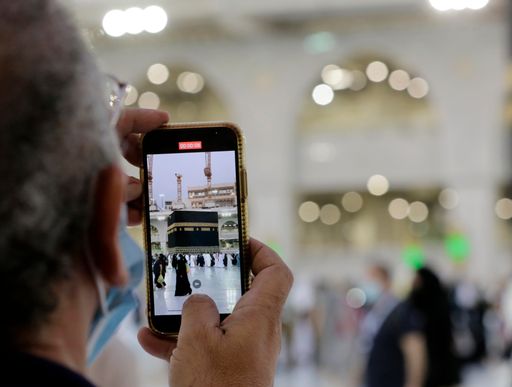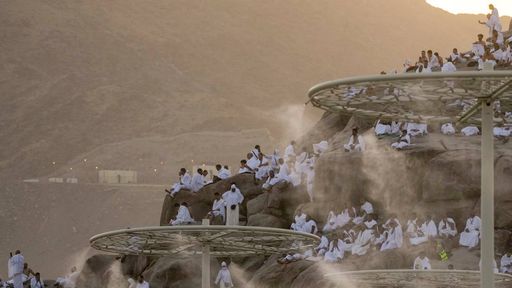As temperatures soar across the region, Saudi Arabia has activated the world’s largest cooling system in the Grand Mosque in Makkah and the Prophet’s Mosque in Madina to ease the holy pilgrimage of Hajj for over a million pilgrims as they begin their journey on Wednesday.
Temperatures are expected to exceed 40° Celsius.
The one of its kind system, according to the Saudi Gazette, has a total capacity of 155,000 tonnes of cooling.
The air conditioning infrastructure of the Grand Mosque, which houses the Kaaba, relies on two main stations: Al-Shamiya Station, with a capacity of 120,000 tonnes, and Ajyad Station, with a capacity of 35,000 tonnes, explained the Saudi newspaper.

Both stations cover the entire complex, including all expansion areas and some of the oldest parts of the mosque which go back to the 16th century, ensuring pilgrims experience moderate and comfortable temperatures ranging from 22° Celsius to 24° Celsius.
To maintain optimal air quality, the system integrates advanced purification technologies capable of removing 95 percent of airborne impurities.
This ensures a clean and safe environment for pilgrims, particularly during the peak summer heat.
All maintenance work, including the replacement of key components, securing work sites, and efficient resource management to accommodate heightened demand during Hajj, will be taken care of by the Haram Authority.
Strict penalties have been enforced against illegal visitors to Makkah to prevent overcrowding.
Last year, Saudi authorities reported that 1,300 Hajj pilgrims died as temperatures reached 50° Celsius. Many were unregistered and lacked access to air-conditioned tents and buses.
According to The National, the Saudi Press Agency reported that “these efforts were a part of a comprehensive vision aimed at elevating the pilgrim experience and providing the highest levels of comfort and tranquillity during ritual performance, especially given the potentially harsh weather conditions.”
Staying indoors
Saudi authorities have also asked pilgrims to remain in their tents for several hours during the high point of this week's pilgrimage, citing high temperatures.
According to a report in Saudi media, Hajj Minister Tawfiq al-Rabiah has requested that pilgrims refrain from leaving their tents between 10:00 am and 4:00 pm on Thursday.

The “Day of Arafat” traditionally marks the high point of the hajj, when pilgrims scale Mount Arafat on the outskirts of Mecca.
There, pilgrims assemble on the 70-metre (230-foot) high hill and its surrounding plain for hours of prayer and Koran recital, staying there until the evening.
There is little to no shade on Mount Arafat, leaving pilgrims directly exposed to the harsh desert sun for hours.
“We warn against climbing mountains or high places on the Day of Arafat, as it causes extreme physical exertion and increases the risk of heat exhaustion,” the health ministry said in a separate statement published by Saudi media.
Temperatures this year are forecast to exceed 40° Celsius as one of the world’s largest annual religious gatherings, bringing together devotees from around the globe, gets under way on Wednesday.
Officials have beefed up heat mitigation measures hoping to avoid a repeat of last year’s hajj, which saw 1,301 pilgrims die as temperatures reached 51.8° Celsius (125.2 Fahrenheit).
This year, authorities have mobilised more than 40 government agencies and 250,000 officials, doubling their efforts against heat-related illness following the lethal heatwave of 2024.
Shaded areas have been expanded by 50,000 square metres (12 acres), thousands more medics will be on standby, and more than 400 cooling units will be deployed, the hajj minister told AFP last week.
As of Sunday, more than 1.4 million pilgrims had arrived in Saudi Arabia for the pilgrimage, officials said.



















